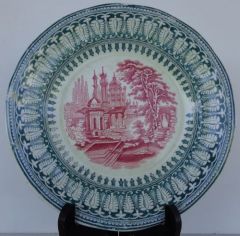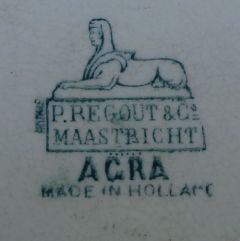Petrus Regout Pottery Factory.


The above decor was first created in 1879.
The Petrus Regout factory was founded in 1836 and situated in the south of
the Netherlands in the town of Maastricht. They produced this sort of
pottery literally by the thousands. The word factory (instead of pottery)
was well deserved here, in the late 1800’s they employed around 2500
people, an amazing number. In 1899 the pottery changed its name to “de
Sphinx”
This pottery never gets much of a mention among Gouda enthusiasts; this
might be because they mainly produced household items as opposed to art
pottery, it could also be because they did not hand paint much of their
pottery, but still, it is good quality pottery and deserves a mention. It
is also still very much handwork, the 2500 people did not just sit
there with their writing pen, but actually worked producing pottery.
The plate above is often referred to as transfer ware, it was produced by
transferring the image from a copper plate onto the pottery; the use of
multiple colours in this process was limited. The use of 2 colours like in
the plate above was apparently easily managed. More colours on the same
plate can be found.
They also used a mix of transfer printing followed up by some hand
painting.
So compared to my other Gouda pottery the painting was a mostly automated
process, but in all fairness I have to say that the PZH also used
techniques to transfer the outline of decor to be painted onto the
pottery, after which painters applied the required colours.
For a multi coloured example of the Petrus Regout earthenware, click
HERE.

